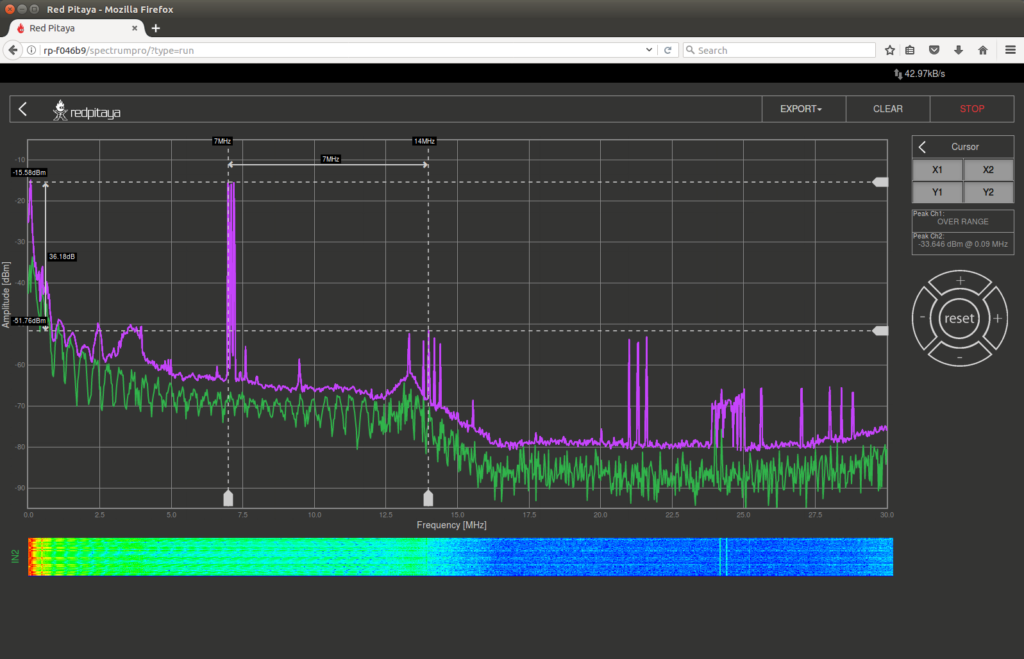I’ve been listening to podcasts while driving for a few years, it seems a good use of my commute time. The SolderSmoke podcast is one of my favourites, I find listening to the relaxed chat about homebrew radio construction very therapeutic. I’ve long had intentions of getting a bit deeper into homebrew radio/electronics (i.e. more than kit-building which is fun but a bit like painting-by-numbers) but the barrier to entry always seemed like a big investment of time that I don’t have. Then along comes Ashar Farhan’s new BITX40 module offering. As soon as I heard about it on the podcast my mind and heart were racing! An almost-ready-to-go PCB of the classic BITX radio, low cost and intended to be modified/hacked. On first release there were some issues with frequency stability… maybe this could also be a use for the PA0KLT VFO kit that I’d received a couple of years ago and had yet to find an application for…? And this would be a great platform for me to play around with some filter design and maybe some DSP without having to build the whole radio myself… within minutes of arriving at my destination my order was placed!
This page is intended to be some notes on my BITX40 project as I progress through various stages. Obviously there are now many hundreds of people modifying BITX40 boards and posting on the Internet about it, I don’t expect to produce anything wildly original here but it’s a useful set of notes for my own purposes.
Enclosure
Built up the digital VFOs as separate modules to allow experimentation with these independent from the full radio rig. Nice that the Raduino can be powered up and worked on solely from a laptop <insert pic>.
I fancy adding a few more features to the display (e.g. convenience features like voltage readout, clock, uptime counter for portable operation, split VFOs, etc.), so have coupled a 4×20 LCD module to the Raduino.
Thought about building the radio into a decent enclosure I have spare but then was persuaded from a few angles to first build it into a £3 biscuit tin, at least while it’s in the experimental stages.
Plans for 28V operation
G4JNT article in RadCom on SMPS noise reduction arrived with perfect timing as I learned that running the BITX40 power amplifier stage on 28V will increase the output power to around 25W. Farhan has cleverly made the board such that separate power supplies can be fed to the PA and the rest of the radio. I plan to copy G4JNT’s filtering of a cheap 12-28V SMPS module in a screened enclosure and place this within the completed BITX40. This should result in the radio running off one 12VDC supply (e.g. battery) and delivering about 25W transmit power.
VFO choices
Onboard VFO, PA0KLT and the arrival of Raduino…
Test equipment
I have a few bits and bobs of surplus test equipment including an old basic analogue oscilloscope but I’d been expecting to buy a Digital Storage Oscilloscope for some time, always wondering what project would tip me over the edge…
My “workshop” is just a small bench at the back of a cold, damp outdoor garage and I’m thankful for it but there isn’t much space for test equipment and it’s not a very nice environment to store decent electronics designed for indoor use. Not much space inside the house either… this led me to consider software scopes and I decided to take a punt on Red Pitaya (OK, so this isn’t necessarily the ‘low cost’ part of the project), specifically a STEMlab 125-10 Diagnostic kit. The scope performance may not be a patch on even the budget Rigol scopes but the Red Pitaya also gives me a logic analyzer, signal generator and even a VNA, all in a small package that fits into my laptop bag. Small is a big deal to me. I’m also interested in learning a bit of Labview and could even start to dabble in a bit of FPGA development with it so the boxes it ticks seem to be boxes that are aimed at someone like me. The BITX40 project will be an interesting exercise to put it through its paces as a bit of general amateur test kit.
2nd harmonic reduction
Scanning the BITX20 io group, it doesn’t take long to see that one of the first hacks many people are making to their BITX40 boards is an additional capacitor to reduce the 2nd harmonic.
Using the Red Pitaya with a short antenna close to a dummy load I’ve measured the 2nd harmonic as between 36 dB and 46 dB down from the fundamental frequency which seems to tie in with some people’s measurements. The 2nd harmonic does indeed appear to be stronger when the radio transmits towards the lower end of the 40m band.

Note the large amount of EMI in the screen capture above is due to the Red Pitaya’s antenna picking up all the domestic lighting and SMPS interference in the house, this would be a lot cleaner if I was measuring the BITX40’s output through line attenuation… maybe I’ll acquire some at some point.
The accepted wisdom to reduce the 2nd harmonic is to fit a 100pF capacitor across L7 on the PCB… to do (waiting for components)…
